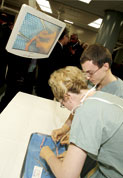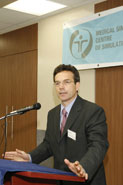New Medical Simulation Centre opens
New Medical Simulation Centre opens McGill University
User Tools (skip):
New Medical Simulation Centre opens
Safe-space training to provide better health care
The aviation industry has long embraced the reality that a fake plane crash is far preferable to a real one. Which is why pilots have, for years, been training on sophisticated flight simulators, where their mistakes cost only mild embarrassment. Now, medical education has adopted the same principle and McGill will be at its cutting edge. On September 14, the new McGill Medical Simulation Centre opened in the La Cité complex on Ave. du Parc. The centre, the first fully-integrated operation of its kind in Canada, heralds a way to train health care professionals more efficiently and thoroughly than ever, allowing them to practice until they make perfect.

Residents Geneviève Nadeau and Danny Del Duca sew a bovine carotid artery. "The AV's going to make [learning] a lot more fun and a lot more interactive," said Del Duca.
Paul Fournier
At the launch, Dean of Medicine Richard Levin quoted Xerox co-founder Alan Kay, saying "the best way to predict the future is to invent it," adding, "Together we walk into the invention of the new future."
Centre director Kevin Lachapelle of the Department of Surgery recalls that when the idea for came up for a McGill take on the fledgling field of hi-tech medical simulation, there was a definite plan to learn from what was out there. "We wanted to create a space that was university wide, where anyone who needed to do technical procedures could train," said Lachapelle. "We needed an integrated simulation centre that uses all simulation modalities. Most centres emphasize one skill or another," he said. "This brings together all modalities outside a clinical setting. And by making it open to many departments, we save on infrastructure costs and economy of scale."
The infrastructure cost $6 million, which was provided from a $21 million grant from the Quebec Ministry of Education as part of larger funding for the province's medical schools. It cost an additional $1.4 million for base building costs such as electrical wiring and ventilation. A separate endowment was created for the operating costs, which are expected to run from $1.2 to $1.5 million annually.

Medical Simulation Centre director Kevin Lachapelle is a staff surgeon at the Royal Victoria Hospital.
Paul Fournier
Each year, the space will be a valuable tool for 2,000 students in medicine, nursing, physical and occupational therapy, and medical residents. Students practice intricate surgical procedures in a large, well-lit room with six long tables where cameras and screens above each station allow observers to closely watch the fine handiwork of delicate tasks. On opening day, Genevieve Nadeau, a first-year resident in general surgery, and Danny Del Duca, a third-year resident in cardiovascular surgery, were sewing a severed carotid artery of a cow. "It feels pretty much the same as a human artery, but it's bigger," Nadeau said.
A cluster of 10 examining rooms provides students with a chance to practice communication skills with mock patients. Each room is equipped with a two-way mirror, cameras and microphones, so the exams can be observed from the central corridor or from a nearby classroom. Actors from a bank of 60 supporting cast will air their carefully scripted ailments so students learn how to take a medical history, examine a patient, respond to faked pain, and deal with distress. Actors also have a makeup and shower room to apply fake bruises and cuts.
In the simulation lab, three specially constructed mannequins are the true guinea pigs for students learning how to clear a patient's airway with a tube, insert a catheter, stick in needles or perform a spinal epidural.
"The goal is to make the whole health system better and safer," said Lachapelle. "Where critiques and self-critiques are in the culture, where it's recognized that mistakes are made. We already produce good doctors and nurses; now there's a better and faster way to train them.

